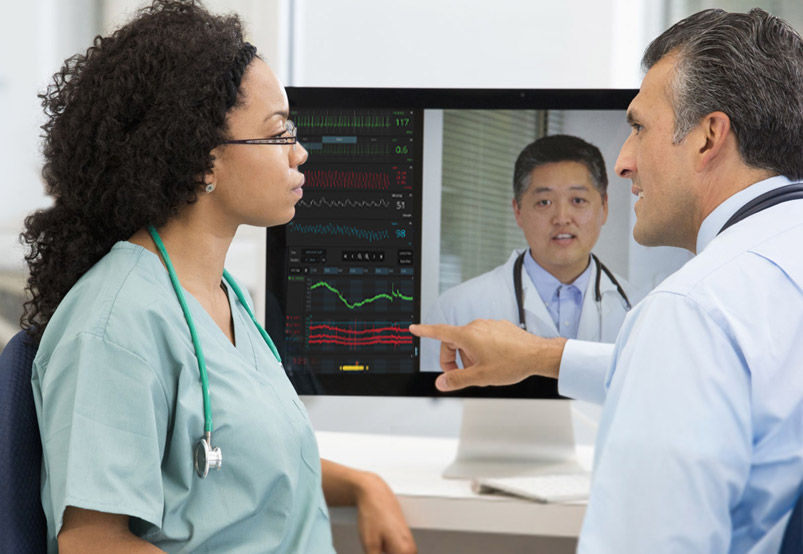
Can someone behind a screen really predict an event before a caregiver at the bedside? With real patient monitoring and patient-centered analytics at scale, the answer is yes.
While digital analytics will never replace the caring hands at a patient’s bedside, what virtual ICUs offer is an important layer of support for caregivers and patients. For years, caregivers had to rely mainly on their expertise and observation of the patient while the data coming from the machines that could help them had been locked away. But the acuity of these sick patients demands more: Physicians and nurses today need tools at their disposal to help in critical decision-making, that will correlate data faster, and over time alert them to potential patient events before they happen.
Why a Virtual ICU
In a multicenter study of ICUs utilizing telemedicine capabilities, researcher Craig Lilly and his team found that ICU telemedicine interventions — specifically interventions that increase early intensivist case involvement — improve adherence to ICU best practices, reduce response times to alarms, and encourage the use of performance data. Overall, ICUs with telemedicine capabilities were associated with lower mortality and lower length of stay. The study comprised 118,990 patients from 56 ICUs in 32 hospitals.
What this tells us quantitatively is what we have known qualitatively for years: Aggregating data in real-time and then processing it into instantly useful information helps care teams make those split-second decisions that can sometimes mean life or death. As we also know, patients in the ICU can crash quickly.
It seems intuitive that hospitals would have a virtual ICU, or have access to one within their system. So why is this tool not currently the standard of care?
Wild, Wild West
Many virtual ICUs pre-date EMRs, which are arguably one of the biggest game-changers in the industry. Because healthcare has changed, virtual ICUs must change, too.
In 2014, the Tele-ICU Committee of the Society of Critical Care Medicine published a study regarding the state of ICU telemedicine, one better defined today as tele-critical care. Rapid evolution in the field in just the past few years necessitated an update of this research in 2019, and this is what was found: Tele-critical care is an established mechanism to leverage critical care expertise to ICUs and beyond, but systematic research comparing different models, approaches, and technologies is still needed.
One might say that today’s landscape is akin to the early days of EMR adoption, a period many refer to as the “Wild, Wild West” because of rapid adoption and the need for hospital systems to move quickly to avoid getting left behind in the technology race.
Consider this: Your hospital has just spent millions on new devices in your ICU. Your hospital is then part of a consolidation with five other facilities, which results in an even greater mix of vendors than you had with just one hospital. You’re now faced with either hiring more intensivists and ICU staff at these smaller, remote hospitals, or purchasing more equipment to consolidate to one single vendor – to the tune of many millions of dollars — so that you can monitor all these patients remotely. This attempted solution is not only costly, but more importantly doesn’t actually give the remote team all the data they need. It also doesn’t lay the foundation to weave in research and analytics into the mix, and it doesn’t scale.
In our experience, throwing more devices at a problem is not the most efficient way to fix it. The answer lies in a software-based solution for the virtual ICU, one that doesn’t require the purchase of new monitoring devices, nor does it take up valuable space in the hospital setting.
Software-based virtual ICU capabilities allow true remote monitoring where the team has access to waveforms across all connected devices. Imagine this:100 patients on a single screen, with staff monitoring beds across vendors, units, and even across facilities within your system. While seeing this visual on a macro scale is exciting, consider the micro, as well. Some virtual ICUs just report on cardiac monitors only, and many just measure 72 hours of time. Others show you snippets but don’t allow you to scroll back in the patient’s history to see trends before events, which is a critical piece of learning. How can you make decisions based on part of the patient’s picture?
Clinicians need the opportunity to see days, weeks, even months of patient data to automate trends specific to that person. And, they need the ability to pull in labs, medications, caregiver observations, and more to get down to the root cause and expedite intervention. A software-based virtual ICU not only enables monitoring, but also added flexibility and scalability. This additional data can now be available to remote teams, keeping everyone updated on all aspects of a patient’s condition – and reaching the true potential of a software-based virtual ICU.
Flexibility in the View
In addition to the flexibility of viewing patients across vendors, units, and facilities, there is also the consideration of other workflows for data viewing. Every facility is different. Every workflow is different. So, if there is only one way of deploying the virtual ICU, that puts constraints on the hospital and often impacts adoption.
A web-based interface ensures that the hospital and users can configure the solution specific to their needs. Options for configuring the design on PCs lower the hardware costs and create more flexibility. Options for embedding views into EMR workflows are important. And, the ability to extend viewing of all collected data beyond the virtual ICU to expedite remote consult with other providers is also critical to realizing the full potential of remote monitoring and telemedicine.
This type of solution can extend beyond virtual ICUs, too. Being able to tie the collected data into other systems, such as middleware and clinical communications, or to launch video from within the virtual ICU, are important considerations. Central command centers and wallboards can easily be created. Integration into home health through the same interface is also now possible — and increasingly crucial as we create more opportunities for care to happen in the home environment. Software-based monitoring and virtual ICUs are the key to ensuring a more extensible, enterprise-wide deployment that gets hospitals beyond the “Wild, Wild West,” and up to speed with the evolution of technology, the opportunities for telemedicine, and the critical care needs of today.
Risk Scoring
What about risk scores? Thanks to machine learning and AI, we are now seeing a rapid evolution of risk scores and predictive analytics in healthcare. Virtual ICUs are no exception. The ability to virtually round on patients based on acuity and risk will further enhance the benefits of remote monitoring and their impact on length of stay, patient care, and outcomes. More facilities are adopting risk scoring as a strategy for maximizing efficiency and focusing providers on the patients who might be most at risk for an event first.
However, consider this: If caregivers are using risk scores based only on cardiac monitoring, a great part of the patient’s overall condition and warning signs might be missed. If risk scores are based on data from the EMR only, there is the potential for the risk scoring to be too late in the prediction, or subject to error due to manually entry of the data point. Predictive analytics are only as good as the information fed into the system.
Furthermore, if risk scores are hard-coded into the central station, monitor, or EMR, with no ability for the hospital and users to influence their variables and the model for predicting, the data that’s informing those scores may not be as individual, or as updated, as it needs to be for the individual institution’s protocols, policies, and patient population.
A system that offers the flexibility to calculate scores from all sources is key, specifically from the real-time waveform data across all connected devices and data from the EMR.
We also believe that giving clinicians the ability to customize and configure their own patient’s risk scores is important. After all, they know their patients best. As hospitals seek answers to how to establish their own risk scores for their own virtual ICUs and other programs, here are some things to consider:
-
Can you create an aggregated risk?
-
Are your risk scores user-configurable?
-
Can you configure risk scores based on your patient population and your idea of risk?
-
Are risks patient-centered?
-
Do you have the capability to create patient-centric alarms?
There is no argument that risk scoring is an important piece of virtual ICUs. In our opinion, to realize their maximum value, care needs to be taken in the process of architecting the system and feeding it information in a way that makes sense for your patient population.
Empowering Clinicians
With the many capabilities offered through a virtual ICU, this is the most important aspect to keep in mind: These tools are meant to supplement, inform and empower clinicians who perform the care.
In a recent Health IT Analytics webcast, “Understanding the Data Challenges of Critical Care,” Reenu Eapen, M.D., a fetal cardiologist with Fetal Care Center in Dallas, discussed the data challenges she and other providers face in caring for critically ill patients.
“Data comes at us from all directions,” Dr. Eapen said on the webcast. “The ability to prioritize and analyze it effectively in taking care of our patients is a very important thing. But limited retrospective data is the best healthcare can offer when it comes to making clinical decisions.”
Cheryl Hiddleson, MSN, RN, CENP, CCRN-E, director of the eICU at Emory Healthcare, also made a point during the webcast about the power of support that virtual ICUs offer to front-line staff as they make critical decisions and provide care.
“Streaming data is constantly moving with no solution to capture it and the interoperability between systems takes too many steps, creates gaps in documentation, and is subject to error. Machine learning will allow for better care but telemedicine is a team approach and we still have to have the human component,” Hiddleson said.
As capable as the tools are, the value of any solution is in giving clinicians the tools they need in the moment to make the most informed decisions, Hiddleson explained.
“The virtual ICU is where you want all that data presented to you, to have algorithms in place that warn you when there is a potential event coming,” Dr. Eapen said. “That only helps the clinician manage those patients better. It’s about helping you do your job more efficiently. It’s about getting another brain on it.”
To empower caregivers, remember that the ability to make “informed decisions” is the goal. As you build your virtual ICU, start with ensuring that the clinicians remotely monitoring patients will have access to all the information they need at the tap of a finger. Consider the workflow and flexibility of that workflow design. Be forward-thinking and prepare for scalability to extend the solution to other hospitals in your system, even in the event of an acquisition or merger, or to support other use cases of the data. And, look for ways to leverage AI and ML into the build, with flexibility to build your own analytics and risk scores to ensure that it meets the needs of your patient population.
Healthcare has more data and technology than we have ever had before. It also has staff shortages, burnout, and an increasingly complex and aging population. Tech-driven solutions like virtual ICUs, remote monitoring, and telehealth will be critical to saving more lives and advancing care in this increasingly complex landscape. These “virtual” capabilities actually mean real opportunities.
A purpose-built approach is key to realizing the full vision without falling short of its promise.




